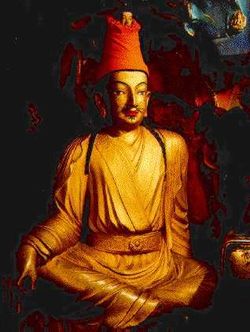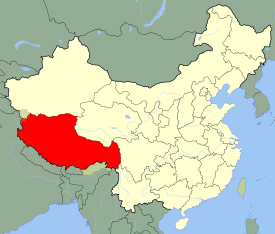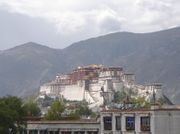Lhasa
| Lhasa 拉萨 ལྷ་ས་ Lasa |
|
|---|---|
| — Prefecture-level city — | |
| 拉萨市 · ལྷ་ས་གྲོང་ཁྱེར་ | |
 |
|
 Lhasa
|
|
| Coordinates: | |
| Country | China |
| Province | Tibet |
| Prefecture | Lhasa |
| Government | |
| - Mayor | Doje Cezhug |
| Area | |
| - Land | 53 km2 (20.5 sq mi) |
| Elevation | 3,490 m (11,450 ft) |
| Population (2009) | |
| - Prefecture-level city | 1,100,123 |
| - Urban | 373,000 |
| - Major Nationalities | Tibetan; Han; Hui |
| - Languages | Tibetan, Mandarin, Jin language (Hothot dialect) |
| Time zone | +8 |
| Area code(s) | 850000 |
| Website | http://www.lasa.gov.cn/ |
| Lhasa | |||||||||||||||
|---|---|---|---|---|---|---|---|---|---|---|---|---|---|---|---|
| Chinese name | |||||||||||||||
| Traditional Chinese | 拉薩 | ||||||||||||||
| Simplified Chinese | 拉萨 | ||||||||||||||
| Hanyu Pinyin | Lāsà | ||||||||||||||
| Literal meaning | place of the gods | ||||||||||||||
|
|||||||||||||||
| Tibetan name | |||||||||||||||
| Tibetan | ལྷ་ས་ | ||||||||||||||
|
|||||||||||||||
Lhasa (pronounced /ˈlɑːsə/ in English, Tibetan: ལྷ་ས་, pronounced [l̥ásə] or [l̥ɜ́ːsə]; simplified Chinese: 拉萨; traditional Chinese: 拉薩; pinyin: Lāsà and sometimes spelled Lasa) is the administrative capital of the Tibet Autonomous Region in the People's Republic of China. At an altitude is 3,490 metres (11,450 ft), Lhasa is one of the highest cities in the world. It is the birthplace of Tibetan Buddhism and contain many religious sites such as the Jokhang, Potala and Norbulingka palaces.
Lhasa is part of a township-level prefecture, the Lhasa Prefecture, consisting of 7 small counties: Lhünzhub County, Damxung County, Nyêmo County, Qüxü County, Doilungdêqên County, Dagzê County and Maizhokunggar County.
Contents |
Etymology
Lhasa literally means "place of the gods", although ancient Tibetan documents and inscriptions demonstrate that the place was called Rasa, which means "goat's place", until the early 7th century.[1]
History
By the mid 7th century, Songtsän Gampo became the leader of the Tibetan Empire that had risen to power in the Brahmaputra River (locally known as the Yarlung River) Valley. After conquering the kingdom of Zhangzhung in the west, he moved the capital from the Chingwa Taktse castle in Chongye County (pinyin: Qonggai), southwest of Yarlung, to Rasa (modern Lhasa) where in 637 he founded the first buildings of the Potala Palace on Mount Marpori. In 641 he founded the Rasa Trulnang or Jokhang.[2] Lhasa soon became not only the religious, but the political centre.[3] Lhasa remained the capital throughout the development of the Tibetan Empire until the reign of Langdarma in the 9th century, when the sacred sites were destroyed and desecrated and the empire fragmented.[4]
In CE 641, Songtsän Gampo, who by this time had conquered the whole Tibetan region, wedded Princess Bhrikuti of Nepal and Princess Wen Cheng of the Imperial Tang court. Through these marriages, he converted to Buddhism and proceeded to build the Jokhang Ramoche Temple in Lhasa in order to house two Buddha statues brought to his court by the princesses. Other building constructed about this time included the nine-storey Pabonka (Pha bong kha) tower and Pabonka Hermitage, and the gompas (temples) of Meru Nyingba, Tsamkhung and Drak Lhaluphuk.[5][6]
Tibetan tradition records that after the death of Songtsen Gampo in A.D. 650, the Chinese Tang dynasty attacked and captured Lhasa.[7][8][9]
Tang dynasty records noted that Songtsän Gampo's empire was still largely nomadic and he held court in large movable resplendent tents, at least when his court moved about the country. The report by a Chinese ambassador in 672 that the Tibetan Emperor did "not live beneath a roof," was doubtless an exaggeration, and probably intended to belittle the country.[10] However, this was probably based on a simple misunderstanding. We learn from a somewhat later ambassador, who arrived in Tibet in 822 CE, that the Tibetan Emperor had his summer headquarters in a large tent just to the north of Lhasa. It is quite clear that this was just a summer encampment and one can only assume that he spent the freezing winters in one of the many building in Lhasa itself. The description of this royal summer camp, as the Chinese Ambassador saw it, is recorded in the Xin Tangshu 216A :
"The valley to the north of the Tsang River (Kyi-chu or Kyi River) is the princely summer camp of the bcan-po. It is surrounded with [a palisade of] posts attached together. At an average distance of ten paces [from each other] 100 lances have been set up; in the middle of which is planted a great standard. There are three gates a hundred paces from each other. Armour clad soldiers guard the gates. Sorcerers with caps of bird [feathers] and a girdle of tiger [skins] thumped on drums. Anyone who entered was searched before they were allowed to proceed. In the middle [of the camp] was a high terrace, surrounded with a rich balustrade. The bcan-po was seated in his tent. [There were] dragons with and without horns, tigers, and panthers, all made of gold. [The bcan-po] was dressed in white linen with a rose-coloured muslin cloth tied around his head. He carried a sword encrusted with gold. The Prime Minister was standing on his right, while the Ministers of State were arranged at the foot of the terrace." [11]
1.jpg)
From the fall of the monarchy in the 9th century to the accession of the 5th Dalai Lama, the centre of political power in the Tibetan region was not situated in Lhasa. However, the importance of Lhasa as a religious site became increasingly significant as the centuries progressed.[12] It was known as the centre of Tibet where Padmasambhava magically pinned down the earth demonness and built the foundation of the Jokhang Temple over her heart.[13]
By the 15th century, the city of Lhasa had risen to prominence following the founding of three large Gelugpa monasteries by Je Tsongkhapa and his disciples. The three monasteries are Ganden, Sera and Drepung which were built as part of the puritanical Buddhist revival in Tibet.[5] The scholarly achievements and political know-how of this sect eventually pushed Lhasa once more to centre stage.
The fifth Dalai Lama, Lobsang Gyatso (1617–1682), conquered Tibet and, in 1642, moved the centre of his administration to Lhasa, which again became both the religious and political capital. In 1645, the reconstruction of the Potala Palace began on Red Hill. In 1648, the Potrang Karpo (White Palace) of the Potala was completed, and the Potala was used as a winter palace by the Dalai Lama from that time onwards. The Potrang Marpo (Red Palace) was added between 1690 and 1694.
The name Potala is possibly derived from Mount Potalaka, the mythological abode of Bodhisattva Avalokiteśvara. The Jokhang Temple was also greatly expanded around this time. Although some wooden carvings and lintels of the Jokhang Temple date to the 7th century, the oldest of Lhasa's extant buildings, such as within the Potala Palace, the Jokhang and some of the monasteries and properties in the Old Quarter date to this second flowering in Lhasa's history.
The Norbulingka summer palace and gardens to the southwest of the city were constructed in the 18th century under the 7th Dalai Lama.[5]
The 11th edition of Encyclopædia Britannica published between 1910–1911 noted the total population of Lhasa, including the lamas in the city and vicinity was about 30,000[14]; a census in 1854 made the figure 42,000, but it is known to have greatly decreased since. Britannica noted that within Lhasa, there were about a total of 1,500 resident Tibetan laymen and about 5,500 Tibetan women.[14] The permanent population also included Chinese families (about 2,000).[14] The city's residents included people from Nepal and Ladak (about 800), and a few from Bhutan, Mongolia and other places.[14] The Britannica noted with interest that the Chinese had a crowded burial-ground at Lhasa, tended carefully after their manner and that the Nepalese supplied mechanics and metal-workers at that time.[14]
In the first half of the 20th century, several Western explorers made celebrated journeys to the city, including William Montgomery McGovern, Francis Younghusband, Alexandra David-Néel and Heinrich Harrer. As Lhasa was the centre of Tibetan Buddhism nearly half of its population were monks.
According to one writer, the population of the city was about 10,000, with some 10,000 monks at Drepung and Sera monasteries 1959[15] Hugh Richardson, on the other hand, puts the population of Lhasa in 1952, before the Chinese occupation, at "some 25,000–30,000—about 45,000–50,000 if the population of the great monasteries on its outskirts be included."[16]
The main gate to the city of Lhasa used to run through a large chorten and contained holy relics of the Buddha Mindukpa.[17]
With the invasion of China many people fled from the city; these included the living 14th Dalai Lama who fled from the Potala Palace into exile in India in 1959 after the Lhasa uprising.
Between 1987–1989 Lhasa experienced major demonstrations, led by monks and nuns, against the Chinese Government's control of Tibet. As a result, the authorities imposed restrictions and political re-education programmes in the monasteries. Many had to go through re-education sessions with the intent of having them align with the Communist views; they were also required to denounce both the Dalai Lama and Tibetan independence. Many monks and nuns who refused to cooperate were sent to prison, while others left the monasteries and escaped to India so that they could carry on with their studies.
In the early 2000s, the city's urban population stood at about 255,000 and has increased to 373,000 at the latest estimate.
Geography and climate
Geography

| Lhasa | ||||||||||||||||||||||||||||||||||||||||||||||||||||||||||||
|---|---|---|---|---|---|---|---|---|---|---|---|---|---|---|---|---|---|---|---|---|---|---|---|---|---|---|---|---|---|---|---|---|---|---|---|---|---|---|---|---|---|---|---|---|---|---|---|---|---|---|---|---|---|---|---|---|---|---|---|---|
| Climate chart () | ||||||||||||||||||||||||||||||||||||||||||||||||||||||||||||
|
||||||||||||||||||||||||||||||||||||||||||||||||||||||||||||
|
||||||||||||||||||||||||||||||||||||||||||||||||||||||||||||
Lhasa prefecture-level city covers an area of close to 30,000 km2 (12,000 sq mi). It has a central area of 544 km2 (210 sq mi)[19] and a total population of 500,000; 250,000 of its people live in the urban area. Lhasa is home to the Tibetan, Han, and Hui peoples, as well as several other ethnic groups, but overall the Tibetan ethnic group makes up a majority of the total population.
Located at the bottom of a small basin surrounded by the Himalaya Mountains, Lhasa has an elevation of about 3,600 m (11,800 ft) [20] and lies in the centre of the Tibetan Plateau with the surrounding mountains rising to 5,500 m (18,000 ft). The air only contains 68% of the oxygen compared to sea level.[4] The Kyi River (or Kyi Chu), a tributary of the Yarlung Zangbo River), runs through the city. This river, known to local Tibetans as the "merry blue waves,", flows through the snow-covered peaks and gullies of the Nyainqêntanglha mountains, extending 315 km (196 mi), and emptying into the Yarlung Zangbo River at Qüxü, forms an area of great scenic beauty.
Climate
Lhasa features a cold steppe climate (Koppen Bsk). Due to its very high altitude, Lhasa has a cool, dry climate with frosty winters. It enjoys nearly 3,000 hours of sunlight annually and is thus sometimes called the "sunlit city" by Tibetans.
Lhasa has an annual precipitation of 426 millimetres (16.8 in) with rain falling mainly in July, August and September. The rainy season is widely regarded the "best" of the year as rains come mostly at night and Lhasa is sunny during the daytime.
- Temperature; Daily average (January) −0.9 °C (30.4 °F); (June and July) 16.5 °C (61.7 °F)
- Precipitation; Monthly average (January) 0.8 mm (0.03 in); (August) 120.6 millimetres (4.75 in), daily rate 6.0 millimetres (0.24 in) .[18]
| Climate data for Lhasa (1971-2000) | |||||||||||||
|---|---|---|---|---|---|---|---|---|---|---|---|---|---|
| Month | Jan | Feb | Mar | Apr | May | Jun | Jul | Aug | Sep | Oct | Nov | Dec | Year |
| Average high °C (°F) | 7.2 (45) |
9.3 (48.7) |
12.7 (54.9) |
15.9 (60.6) |
19.9 (67.8) |
23.2 (73.8) |
22.6 (72.7) |
21.4 (70.5) |
19.9 (67.8) |
17.0 (62.6) |
12.1 (53.8) |
8.0 (46.4) |
15.8 (60.4) |
| Average low °C (°F) | −9.0 (16) |
−5.8 (21.6) |
−2.1 (28.2) |
1.5 (34.7) |
5.6 (42.1) |
9.8 (49.6) |
10.4 (50.7) |
9.7 (49.5) |
7.7 (45.9) |
2.0 (35.6) |
−4.2 (24.4) |
−8.2 (17.2) |
1.4 (34.5) |
| Precipitation mm (inches) | .8 (0.031) |
1.2 (0.047) |
2.9 (0.114) |
6.1 (0.24) |
27.7 (1.091) |
71.2 (2.803) |
116.6 (4.591) |
120.6 (4.748) |
68.3 (2.689) |
8.8 (0.346) |
1.3 (0.051) |
1.0 (0.039) |
426.4 (16.787) |
| % Humidity | 28 | 26 | 27 | 36 | 44 | 51 | 62 | 66 | 63 | 49 | 38 | 34 | 43.7 |
| Avg. precipitation days (≥ 0.1 mm) | .7 | 1.0 | 1.6 | 4.3 | 9.9 | 14.3 | 19.1 | 20.0 | 15.4 | 4.5 | .7 | .6 | 92.1 |
| Sunshine hours | 250.9 | 226.7 | 246.1 | 248.9 | 276.6 | 257.3 | 227.4 | 219.6 | 229.0 | 281.7 | 267.4 | 258.6 | 2,990.1 |
| Source: China Meteorological Administration [18] | |||||||||||||
Administration

Administratively speaking, Lhasa is a prefecture-level city that consists of one district and seven counties. Chengguan District comprise the city of Lhasa.
| Map | ||||||||
|---|---|---|---|---|---|---|---|---|
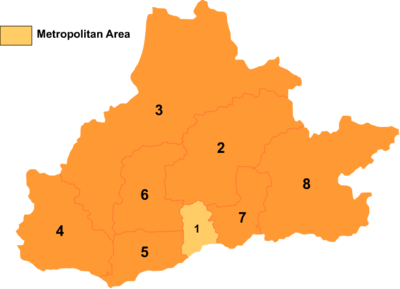 |
||||||||
| # | Name | Hanzi | Hanyu Pinyin | Tibetan | Wylie | Population (2003 est.) | Area (km²) | Density (/km²) |
| 1 | Chengguan District | 城关区 | Chéngguān Qū | ཁྲིན་ཀོན་ཆུས་ | khrin kon chus | 140,000 | 525 | 267 |
| 2 | Lhünzhub County | 林周县 | Línzhōu Xiàn | ལྷུན་གྲུབ་རྫོང་ | lhun grub rdzong | 60,000 | 4,100 | 1 |
| 3 | Damxung County | 当雄县 | Dāngxióng Xiàn | འདམ་གཞུང་རྫོང | dam gzhung rdzong | 40,000 | 10,234 | 4 |
| 4 | Nyêmo County | 尼木县 | Nímù Xiàn | སྙེ་མོ་རྫོང་ | snye mo rdzong | 30,000 | 3,266 | 9 |
| 5 | Qüxü County | 曲水县 | Qūshuǐ Xiàn | ཆུ་ཤུར་རྫོང་ | chu shur rdzong | 30,000 | 1,624 | 18 |
| 6 | Doilungdêqên County | 堆龙德庆县 | Duīlóngdéqìng Xiàn | སྟོད་ལུང་བདེ་ཆེན་རྫོང་ | stod lung bde chen rdzong | 40,000 | 2,672 | 15 |
| 7 | Dagzê County | 达孜县 | Dázī Xiàn | སྟག་རྩེ་རྫོང་ | stag rtse rdzong | 30,000 | 1,361 | 22 |
| 8 | Maizhokunggar County | 墨竹工卡县 | Mòzhúgōngkǎ Xiàn | མལ་གྲོ་གུང་དཀར་རྫོང་ | mal gro gung dkar rdzong | 40,000 | 5,492 | 7 |
Economy
Competitive industry together with feature economy play key roles in the development of Lhasa. With the view to maintaining a balance between population growth and the environment, tourism and service industries are emphasised as growth engines for the future.
Agriculture and animal husbandry in Lhasa are considered to be of a high standard. People mainly plant highland barley and winter wheat. The resources of water conservancy, geothermal heating, solar energy and various mines are abundant.
There is widespread electricity together with the use of both machinery and traditional methods in the production of such things as textiles, leathers, plastics, matches and embroidery. The production of national handicrafts has made great progress.
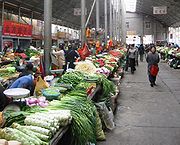
With the growth of tourism and service sectors, the sunset industries which cause serious pollution are expected to fade in the hope of building a healthy ecological system. Environmental problems such as soil erosion, acidification, and loss of vegetation are being addressed.
The tourism industry now brings significant business to the region, building on the attractiveness of the Potala Palace, the spectacular Himalayan landscape together with the many wild plants and animals native to the high altitudes of Central Asia. Many of Lhasa's rural residents practice traditional agriculture and animal husbandry. Lhasa is also the traditional hub of the Tibetan trading network. For many years, chemical and car making plants operated in the area and this resulted in significant pollution, a factor which has changed in recent years. Copper, lead and zinc are mined nearby and there is ongoing experimentation regarding new methods of mineral mining and geothermal heat extraction.
Demographics
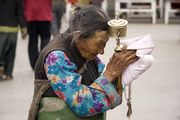

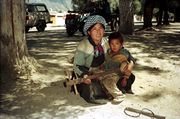
Tibetan exile groups assert that ethnic Tibetans are now in a minority in Lhasa, because of the influx of migrants from other parts of the Peoples' Republic of China over the past years (particularly Han and Hui Chinese). This is backed up by many foreign journalists who have reported from the city.[21][22] Officially, the total population of Lhasa Prefecture-level City is 521,500 (including known migrant population but excluding military garrisons). Of this, 257,400 are in the urban area (including a migrant population of 100,700), while 264,100 are outside.[23] Nearly half of Lhasa Prefecture-level City's population lives in Chengguan District, which is the administrative division that contains the urban area of Lhasa (i.e. the actual city).
According to the 2000 census, the ethnic distribution in Lhasa Prefecture-level City was as follows in November 2000:
| Major ethnic groups in Lhasa Prefecture-level City by district or county, 2000 census[24] | |||||||
|---|---|---|---|---|---|---|---|
| Total | Tibetans | Han Chinese | others | ||||
| Lhasa Prefecture-level City | 474,499 | 387,124 | 81.6% | 80,584 | 17.0% | 6,791 | 1.4% |
| Chengguan District | 223,001 | 140,387 | 63.0% | 76,581 | 34.3% | 6,033 | 2.7% |
| Lhünzhub County | 50,895 | 50,335 | 98.9% | 419 | 0.8% | 141 | 0.3% |
| Damxung County | 39,169 | 38,689 | 98.8% | 347 | 0.9% | 133 | 0.3% |
| Nyêmo County | 27,375 | 27,138 | 99.1% | 191 | 0.7% | 46 | 0.2% |
| Qüxü County | 29,690 | 28,891 | 97.3% | 746 | 2.5% | 53 | 0.2% |
| Doilungdêqên County | 40,543 | 38,455 | 94.8% | 1,868 | 4.6% | 220 | 0.5% |
| Dagzê County | 24,906 | 24,662 | 99.0% | 212 | 0.9% | 32 | 0.1% |
| Maizhokunggar County | 38,920 | 38,567 | 99.1% | 220 | 0.6% | 133 | 0.3% |
(Excluding People's Liberation Army garrison in active service)
The Tibetan government in exile assert that, if the excluded military garrisons and migrants from outside Tibet were to be considered, ethnic Tibetans would be seen as being a minority in Lhasa. Resentment at the relative wealth and influence of the newcomers was one of the reasons behind the recent unrest in the city.
Culture and landmarks

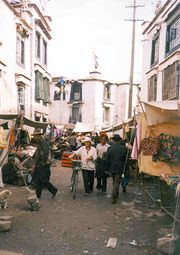
Lhasa has many sites of historic interest, including the Potala Palace, Jokhang Temple, Sera Monastery, Zhefeng Temple, Drepung Monastery and Norbulingka. The Potala Palace, Jokhang Temple and the Norbulingka are UNESCO world heritage sites. [25]However, many important sites were damaged or destroyed mostly, but not solely, during the Cultural Revolution.[26][27][28]
The city of Lhasa contains three concentric paths used by pilgrims to circumambulate (walk around) the sacred Johkhang Temple, many of whom make full or partial prostrations along these routes in order to gain spiritual merit. The innermost, the Nangkor (Nang-skor), is contained within the Jokhang Temple, and surrounds the sanctuary of the Jowo Shakyamuni, the most sacred statue in Tibetan Buddhism. The middle circumambulatory, the Barkor (Bar-skor), passes through the Old Town and surrounds the Jokhang Temple and various other buildings in its vicinity. The outer Lingkor (Gling-skor) encircles the entire traditional city of Lhasa. Due to the construction of a large new street, Beijing Lam, the Lingkor is not usually used by pilgrims.
Every August the Shoton Festival, one of Tibet's biggest traditional festivals, is held in Lhasa; it was first held in the 7th century.
Food in Lhasa can also be seen as part of the culture. Usually, Tibetans live on mutton and beef. Especially for the herdsmen, who dry the mutton and beef before winter comes so that there are supplies during the cold months. Wine is indispensable to Tibetans, who brew it with Qingke, a kind of crop which grows on Qingzang Plateau.
Landmarks
- Potala Palace
- Barkhor
- Tromzikhang
- Jokhang
- Norbulingka
- Lingkhor
- Muru Nyingba
- Chokpuri
- North Linkor Road
- Tibet University
- Tibet Museum
- Lhasa Carpet Factory
- Lhasa Hotel
- Lhasa railway station
- Lhasa west railway station
- Central Beijing Road
Tourism
According to the region's authorities, 1.1 million people visited Tibet in 2004. Chinese authorities plan an ambitious growth of tourism in the region aiming at 10 million visitors by 2020; these visitors are expected to be mostly ethnic Chinese. Proponents of greater Tibetan autonomy are concerned that the increase in tourism will lead to an erosion of the indigenous culture of Tibet; in particular, these proponents have stated that renovation around historic sites, such as the Potala Palace, a UNESCO World Heritage Site, are creating a jarring "Disney-like" degradation of the sacred site.[29]
Transport
Railway
The new Lhasa Railway which proceeds north and then east to Xining, some 2000 km, is the highest plateau railway in the world. Journalists report that the opening of the railway in July 2006 has brought with it an increasing demand for property which has pushed prices up.
Five trains arrive at and depart from Lhasa railway station each day. Train numbered T27 takes 47 hours, 28 minutes from Beijing West, arrives in Lhasa at 20:58 every day. The ticket costs 389 yuan for 'hard seat', or 813 yuan for a lower 'hard sleeper', 1262 yuan for a lower 'soft sleeper'. T28 from Lhasa to Beijing West departs at 08:00 and arrives in Beijing at 08:00 on the third day, taking 48 hours. There are also trains from Chengdu, Chongqing, Lanzhou, Xining, Guangzhou, and Shanghai. Initially the large altitude difference has caused problems on this route, giving passengers altitude sickness. To counter this, extra oxygen is pumped in through the ventilation system, and personal oxygen masks are available.[30]
Air Transport
Lhasa Gonggar Airport is located about one hour's taxi ride south from the city. There are flight connections to several Chinese cities including Beijing and Chengdu, and to Kathmandu in Nepal.
Highway
- The Qinghai-Tibet Highway (part of G109) runs to northeast toward Xining and eventually to Beijing and is the mostly used road.
- The Sichuan-Tibet Highway (part of G318) runs east towards Chengdu and eventually to Shanghai. G318 also runs west toward Zhangmu on the Nepal border.
- The Xinjiang-Tibet Highway (G219) runs north to Yecheng, Xinjiang. This road is rarely used due to the lack of amenities and petrol stations.
Lhasa in entertainment
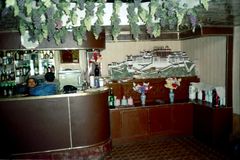
Life in Lhasa was covered by Austrian mountaineer Heinrich Harrer in his book Seven Years in Tibet and the film of that same name which starred Brad Pitt and David Thewlis. The book in particular relates the story of his life in Lhasa during the 1940s. His autobiography, Beyond Seven Years in Tibet, published in English in 2007 also gives a perspective on his time in Lhasa.
There are some night spots which feature cabaret acts in which performers sing in English, Chinese, Tibetan, and Nepalese songs and dancers wear traditional Tibetan costume with long flowing cloth extending from their arms. There are a number of small bars which feature live music, although they typically have limited drink menus and cater mostly to foreign tourists.
Gallery
 Stone lion. Lhasa. 1938. |
 Lhasa streetscene. 1938. |
 Vendor in Lhasa market. 1938. |
 Erecting a prayer pole. Lhasa. 1938. |
 Foodstall. Lhasa. 1938. |
 Lhasa is located in the Lhasa Valley of Tibet. |
|
 View of the main road in Lhasa. |
Sister cities
Lhasa has four sister cities:[31]
 Boulder, Colorado, United States, since 1987
Boulder, Colorado, United States, since 1987 Potosí, Bolivia, since 1995
Potosí, Bolivia, since 1995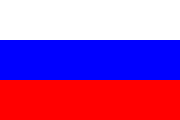 Elista, Kalmykia, Russia, since 2004
Elista, Kalmykia, Russia, since 2004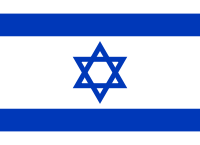 Beit Shemesh, Israel, since 2007
Beit Shemesh, Israel, since 2007
Footnotes
- ↑ Kolmaš, Josef. (1967) Tibet and Imperial China: A Survey of Sino-Tibetan Relations up to the end of the Manchu Dynasty in 1912, p. 7. Occasional paper 7. The Australian National University-Centre of Oriental Studies, Canberra.
- ↑ Dorje (1999), pp. 68, 201-202.
- ↑ Stein (1972), p. 38.
- ↑ 4.0 4.1 Dorje (1999), p. 68.
- ↑ 5.0 5.1 5.2 Dorje (1999), p. 69.
- ↑ Dowman (1988), p. 65.
- ↑ Charles Bell (1992). Tibet Past and Present. CUP Motilal Banarsidass Publ.. p. 28. ISBN 8120810481. http://books.google.com/books?id=U7C0I2KRyEUC&pg=PA28&dq=chinese+captured+lhasa+650&hl=en&ei=zfRNTJCsOcT48Aa24vnyCw&sa=X&oi=book_result&ct=result&resnum=2&ved=0CDQQ6AEwAQ#v=onepage&q=chinese%20captured%20lhasa%20650&f=false. Retrieved 2010-7-17.
- ↑ University of London. Contemporary China Institute, Congress for Cultural Freedom (1960). The China quarterly, Issue 1. p. 88. http://books.google.com/books?id=faoSAAAAIAAJ&q=chinese+captured+lhasa+650&dq=chinese+captured+lhasa+650&hl=en&ei=zfRNTJCsOcT48Aa24vnyCw&sa=X&oi=book_result&ct=result&resnum=5&ved=0CEIQ6AEwBA. Retrieved 2010-7-17.
- ↑ Roger E. McCarthy (1997). Tears of the lotus: accounts of Tibetan resistance to the Chinese invasion, 1950-1962. McFarland. p. 12. ISBN 0786403314. http://books.google.com/books?id=Ecaeybfrl1IC&pg=PA12&dq=chinese+captured+lhasa+650&hl=en&ei=zfRNTJCsOcT48Aa24vnyCw&sa=X&oi=book_result&ct=result&resnum=1&ved=0CC8Q6AEwAA#v=onepage&q=chinese%20captured%20lhasa%20650&f=false. Retrieved 2010-7-17.
- ↑ Stein (1972), p. 118.
- ↑ From the French translation by Pelliot (1961), pp. 130-131.
- ↑ Bloudeau, Anne-Mari & Gyatso, Yonten. 'Lhasa, Legend and History' in Lhasa in the Seventeenth Century: The Capital of the Dalai Lamas, 2003, pp. 24-25.
- ↑ Bloudeau, Anne-Mari & Gyatso, Yonten. "Lhasa, Legend and History." In: Lhasa in the Seventeenth Century: The Capital of the Dalai Lamas. Françoise Pommaret-Imaeda, Françoise Pommaret 2003, p. 38. Brill, Netherlands. ISBN 9789004128668.
- ↑ 14.0 14.1 14.2 14.3 14.4 LHASA. Online Encyclopedia. Search over 40,000 articles from the original, classic Encyclopedia Britannica, 11th Edition
- ↑ Dowman (1988), p. 39.
- ↑ Richardson (1984), p. 7.
- ↑ Tung (1980), caption to plate 17, p. 42.
- ↑ 18.0 18.1 18.2 "中国地面国际交换站气候标准值月值数据集" (in Simplified Chinese). China Meteorological Administration. http://cdc.cma.gov.cn/shuju/index3.jsp?tpcat=SURF&dsid=SURF_CLI_CHN_MUL_MMON_19712000_CES&pageid=3. Retrieved 2010-05-04.
- ↑ National Geographic Atlas of China (2007), p. 88. National Geographic, Washington, D.C. ISBN 978-1426201363.
- ↑ National Geographic Atlas of China. (2008), p. 88. National Geographic, Washington D.C. ISBN 978-1-4262-0136-3.
- ↑ China cracks down on protests in Tibet
- ↑ Midnight ultimatum for Tibet showdown
- ↑ People's Government of Lhasa Official Website - "Administrative divisions"
- ↑ Department of Population, Social, Science and Technology Statistics of the National Bureau of Statistics of China (国家统计局人口和社会科技统计司) and Department of Economic Development of the State Ethnic Affairs Commission of China (国家民族事务委员会经济发展司), eds. Tabulation on Nationalities of 2000 Population Census of China (《2000年人口普查中国民族人口资料》). 2 vols. Beijing: Nationalities Publishing House (民族出版社), 2003. (ISBN 7-105-05425-5)
- ↑ "Historic Ensemble of the Potala Palace, Lhasa". unesco. http://whc.unesco.org/en/list/707. Retrieved 2008-02-10.
- ↑ Bradley Mayhew and Michael Kohn. Tibet. 6th Edition (2005), pp. 36-37. Lonely Planet. ISBN 1-74059-523-8
- ↑ Keith Dowman. The Power-Places of Central Tibet: The Pilgrim's Guide, (1988) pp. 8-13. Routledge & Kegan Paul, Ltd., London and New York. ISBN 0-7102-1370-0.
- ↑ Laird, Thomas. (2006). The Story of Tibet: Conversations with the Dalai Lama, pp. 345-351.Grove Press, New York. ISBN 978-0-8021-1827-1.
- ↑ Miles, Paul (8 April 2005). "Tourism drive 'is destroying Tibet'". London: Telegraph. http://www.telegraph.co.uk/travel/732642/Tourism-drive-is-destroying-Tibet.html. Retrieved 20 May 2009.
- ↑ Cody, Edward. The Washington Post. http://www.washingtonpost.com/wp-dyn/content/article/2006/07/03/AR2006070301219.html. Retrieved 2010-05-07.
- ↑ Lhasa city guide
References
- Das, Sarat Chandra. 1902. Lhasa and Central Tibet. Reprint: Mehra Offset Press, Delhi. 1988. ISBN 81-86230-17-3
- Dorje, Gyurme. 1999. Footprint Tibet Handbook. 2nd Edition. Bath, England. ISBN 1 900949 33 4. Also published in Chicago, U.S.A. ISBN 0 8442-2190-2.
- Dowman, Keith. 1988. The Power-Places of Central Tibet: The Pilgrim's Guide, p. 59. Routledge & Kegan Paul. London. ISBN 0-7102-1370-0 (ppk).
- Liu, Jianqiang (2006). chinadialogue - Preserving Lhasa's history (part one).
- Miles, Paul. (April 9, 2005). "Tourism drive 'is destroying Tibet' Unesco fears for Lhasa's World Heritage sites as the Chinese try to pull in 10 million visitors a year by 2020". Daily Telegraph (London), p. 4.
- Pelliot, Paul. (1961) Histoire ancienne du Tibet. Libraire d'Amérique et d'orient. Paris.
- Richardson, Hugh E (1984). Tibet and its History. Second Edition, Revised and Updated. Shambhala Publications, Boston. ISBN 0-87773-376-7.
- Richardson, Hugh E (1997). Lhasa. In Encyclopedia Americana international edition, (Vol. 17, pp. 281–282). Danbury, CT: Grolier Inc.
- Stein, R. A. (1972). Tibetan Civilization, p. 38. Reprint 1972. Stanford University Press. ISBN 0-8047-0806-1 (cloth); ISBN 0-8047-0901-7 (paper).
- Tung, Rosemary Jones. 1980. A Portrait of Lost Tibet. Thomas and Hudson, London. ISBN 0 500 54068 3.
- Vitali, Roberto. 1990. Early Temples of Central Tibet. Serindia Publications. London. ISBN 0-906026-25-3.
- (2006). Lhasa - Lhasa Intro
- von Schroeder, Ulrich. (1981). Indo-Tibetan Bronzes. (608 pages, 1244 illustrations). Hong Kong: Visual Dharma Publications Ltd. ISBN 962-7049-01-8
- von Schroeder, Ulrich. (2001). Buddhist Sculptures in Tibet. Vol. One: India & Nepal; Vol. Two: Tibet & China. (Volume One: 655 pages with 766 illustrations; Volume Two: 675 pages with 987 illustrations). Hong Kong: Visual Dharma Publications, Ltd.). ISBN 962-7049-07-7
- von Schroeder, Ulrich. 2008. 108 Buddhist Statues in Tibet. (212 p., 112 colour illustrations) (DVD with 527 digital photographs). Chicago: Serindia Publications. ISBN 962-7049-08-5
External links
- People's Government of Lhasa Official Website
- Lhasa @ China Tibet Information Center
- Lhasa Nights art exhibition
- Grand temple of Buddha at Lhasa in 1902, Perry-Castañeda Library Map Collection
Videos
- Short form of a video travelogue to Lhasa - the skyway over Sichuan-Tibet Highway to Lhasa, Potala Palace, Jokhang Temple, Serena Monastery, Tibet Train from Lhasa to Chengdu
Maps and aerial photos
|
|||||||||||||||
|
||||||||||||||||||||||
|
|||||||
|
|||||||||||||||
|
||||||||||||||||||||||
